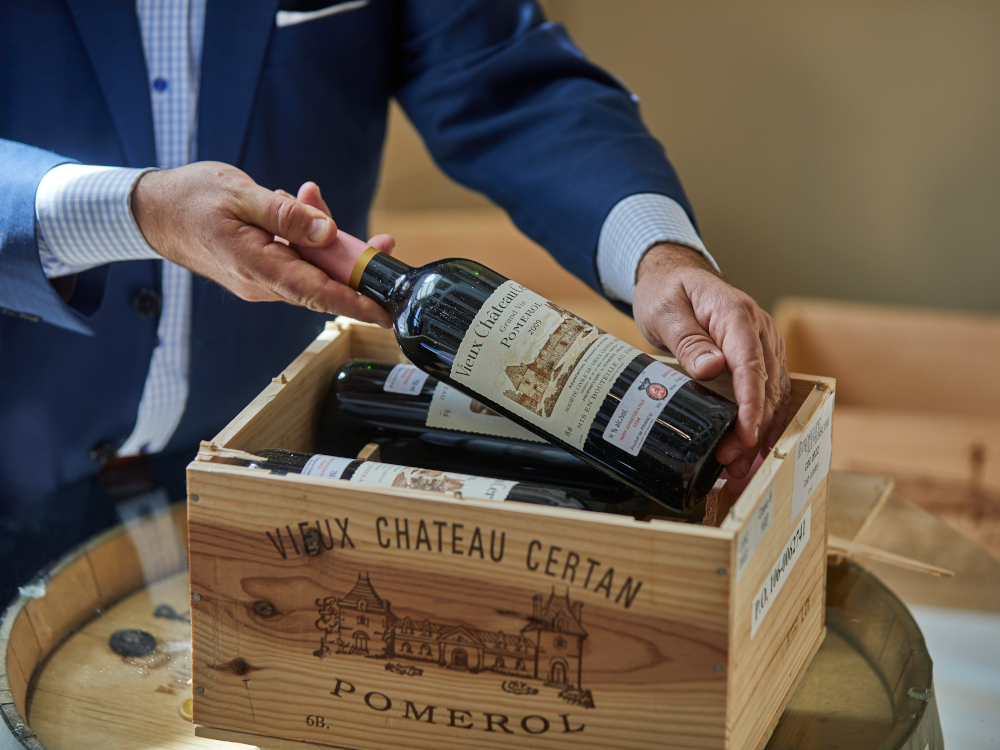This is the 10th in a series of articles in our special report on alternative investments in Canada. To see all the articles, click here.
At some point, serious wine lovers might pause after a particularly delicious sip and wonder, “Should I start a wine collection?” But how—and will it—accrue in value, and what are the possible risks and rewards? We asked experts to weigh in.

A serious collection begins with around 200 to 500 bottles, depending on whom you ask, and can range into the thousands. Few wine collectors are primarily speculators, however.
Marc Russell is founder and CEO of Fine Wine Reserve, a dedicated wine storage business with two facilities in the Toronto area. He says about two-thirds of his clients are what he calls “true wine aficionados.”
An additional 20 per cent are young, affluent people who see wine as part of the lifestyle they have attained (or aspire to). About 10 per cent are simply collectors, who might have focused on coins or sports memorabilia but picked wine instead.
Fewer than 3 per cent, he estimates, are “purely into it for investment purposes.”
Most people start by collecting what they like to drink, then become more serious as they learn more about it, says Steven Joe, a senior financial planner with Assante Financial Management in Vancouver.

Although traditional investment management is his business, “for me wine is really about creating experiences and giving gifts.” He has been collecting for about 15 years.
At the start, you should decide whether you’re collecting for pleasure or profit, says John Szabo, one of Canada’s tiny handful of Master Sommeliers and a critic at WineAlign, which publishes reviews and other wine-related content. Szabo also offers buying guidance as a consultant to collectors.
He refers to a survey conducted by Wine X magazine estimating that about half of the wine collections around the world number between 150 and 1,000 bottles, with the other half at between 1,000 and 5,000.
“If you’re buying for investment, 200 to 300 labels are investment-grade wines that are pretty blue-chip,” he adds. “I suggest buying case lots and never opening it. There is a premium to be paid for wine OWC: in the original wooden case.”
But, he says, “almost invariably people buy too much wine. You need to decide right at the top whether you’re collecting for pleasure or profit.”
It’s somewhat difficult to buy the most desirable wines in Canada because alcohol sales are so tightly controlled. In Ontario, which has some of the strictest regulation, wine can only be purchased through the LCBO or at auctions run through Waddington’s. Regulation of interprovincial wine sales is also tight, although it is under review.
Some provinces, such as Alberta, are less restrictive, but even so, to buy any quantity of a desirable wine, “you need to have some kind of pull with the importer or the retailer; you’ve got to be a pretty good client to get an allocation,” says Steven Joe.

Other options include private estate sales and auctions, where collectors can buy older bottles that are “well aged and well cared for,” says Warren Porter, CEO of Calgary’s Iron Gate Wine, Canada’s pre-eminent wine auction house. For out-of-province buyers, “we transfer the title of the asset in Alberta and put them in touch with a shipping company,” he adds.
“If you’re going to be drinking it within the next four to six years, you can get away with basic climate control,” says Russell. Ideally, he says, wine should be stored at a stable 8 to 15 degrees, with high humidity.
Typically, collectors will keep some bottles that they intend to drink within a few months in their own homes. But most North American houses aren’t built for long-term storage.
“That’s what separates the professional from the other places,” he says. “We’re fogging the air all winter long; our humidity levels never go less than 60 per cent. We are re-creating what is deemed the best climate for wine—the damp European cellar.”
Generally speaking, top wines increase in value with age, but there are limits. John Szabo laments that he sees too many cellars stocked with wine past its prime, and with too many bottles for the owner to drink in a lifetime.
So when should people decide to let go?
Porter offers a list of what he calls “the 6 D’s”—reasons people sell their wine collections. They are divorce, debt, death, going dry, downsizing and development, or culling parts of the collection to make room for new acquisitions.
“We get a lot of collections that come to us because people have bought the good vintages, the great wines, in the 1980s, and they are realizing a substantial profit,” Porter says.
What if somebody dies and bequeaths a thousand bottles?

“Wine falls under a category called personal use property, so you don’t have to pay tax on it until it’s over $1,000 per item,” says Steven Joe. Collectors or their heirs may end up donating (or drinking) the costliest bottles to avoid or reduce capital gains at death, he says, and a major collection should certainly be covered in a will.
Few collectors are in it purely for profit. One reason, says Russell, is that it’s not as much fun as collecting to taste, learn about and share.
“To make money in the wine investment area, you have to buy certain types of wine, the trophy wines that are traded and that really do appreciate in value and that are easy to liquidate,” he says. Despite their cachet, these big-name bottles may have more value for their rarity than for their flavour.
A shopping list of true investment wines might start with examples
from Bordeaux’s great chateaux, including Haut-Brion, Lafite Rothschild,
Latour, Margaux and Mouton Rothschild, and follow with labels from
France’s Burgundy region, Italy’s Barolo, Barbaresco and Montalcino
and California’s Napa Valley. A single bottle may cost $1,500 and up,
but the price variation is wide. In a recent Iron Gate auction, one
1959 Chateau Haut-Brion was estimated to sell for between $3,200 and
$4,400, while a pair of 1971 bottles from the same producer were
expected to go for $1,000 to $1,500.
Anyone thinking of investing needs to consider supply and demand, says Joe. Climate change and other factors may reduce supply, driving up the price, but “on the demand side, it’s pretty clear that younger people are drinking less. With the next generation that’s going to be buying wine, the average number of drinks per week is down in the 20 per cent to 30 per cent range.”
Investors must consider other factors as well when investing in wine, among them liquidity, regulation, taxation, valuation and storage costs, Joe says.
“There’s limited transparency in the market, and it’s a perishable asset,” he says. “There’s minimal investor protection in wine: If you buy a bad batch, you have no recourse.”
Szabo says, “I’ve certainly seen wine indexes outperforming various stock markets around the world, but wine is pleasure first and foremost. If it all goes south, at the very least you’ve got a lot of great wine you can drink.”
For others, the social aspect trumps almost everything else.
“Very seldom do you see someone holding on to that special bottle of wine for themselves,” says Constantine Patiniotis, founder and president of the Vintage Conservatory in Toronto, a wine storage service that also provides dining and tasting opportunities for people who want to enjoy their collections.
“They’re holding onto it to share it, and they want to have as many special bottles to share with as many people as they can.”
The Canadian Family Offices newsletter comes out on Sundays and Wednesdays. If you are interested in stories about Canadian enterprising families, family offices and the professionals who work with them, but like your content aggregated, you can sign up for our free newsletter here.
Please visit here to see information about our standards of journalistic excellence.




